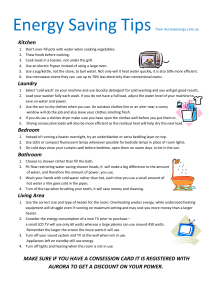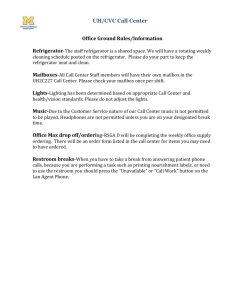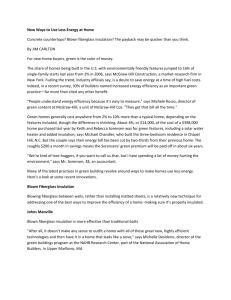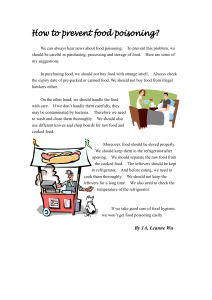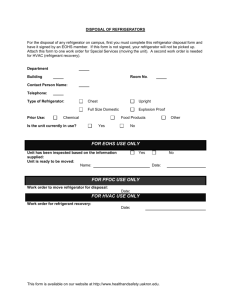Saving energy makes sense
advertisement
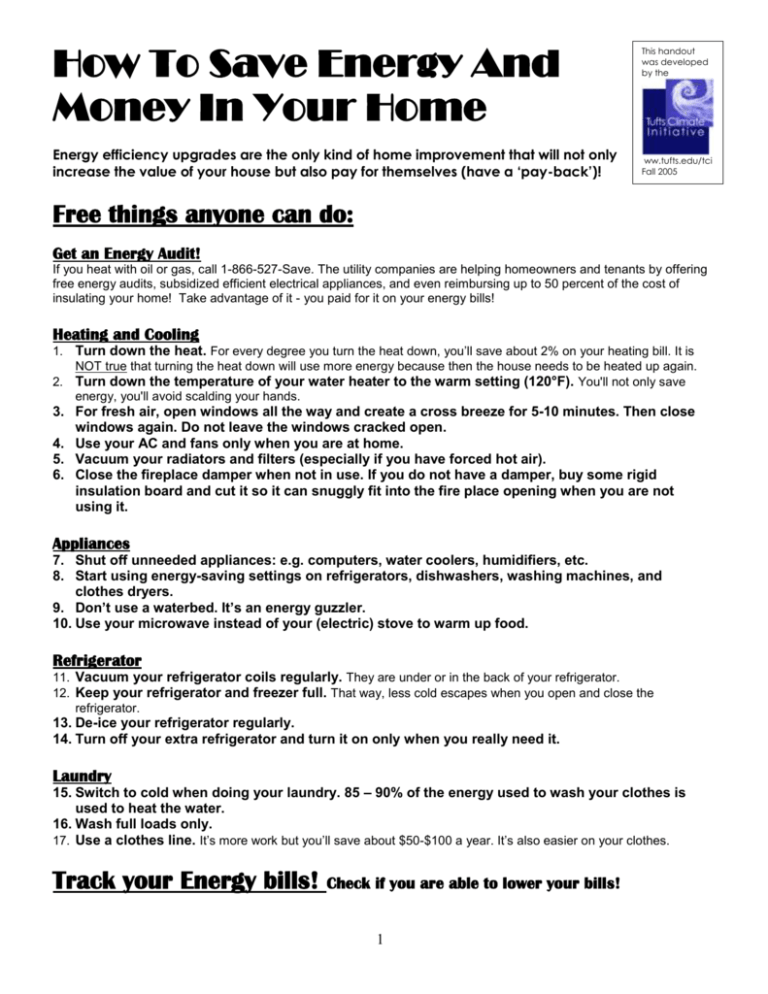
How To Save Energy And Money In Your Home Energy efficiency upgrades are the only kind of home improvement that will not only increase the value of your house but also pay for themselves (have a ‘pay-back’)! This handout was developed by the ww.tufts.edu/tci Fall 2005 Free things anyone can do: Get an Energy Audit! If you heat with oil or gas, call 1-866-527-Save. The utility companies are helping homeowners and tenants by offering free energy audits, subsidized efficient electrical appliances, and even reimbursing up to 50 percent of the cost of insulating your home! Take advantage of it - you paid for it on your energy bills! Heating and Cooling 1. Turn down the heat. For every degree you turn the heat down, you’ll save about 2% on your heating bill. It is NOT true that turning the heat down will use more energy because then the house needs to be heated up again. 2. Turn down the temperature of your water heater to the warm setting (120°F). You'll not only save energy, you'll avoid scalding your hands. 3. For fresh air, open windows all the way and create a cross breeze for 5-10 minutes. Then close windows again. Do not leave the windows cracked open. 4. Use your AC and fans only when you are at home. 5. Vacuum your radiators and filters (especially if you have forced hot air). 6. Close the fireplace damper when not in use. If you do not have a damper, buy some rigid insulation board and cut it so it can snuggly fit into the fire place opening when you are not using it. Appliances 7. Shut off unneeded appliances: e.g. computers, water coolers, humidifiers, etc. 8. Start using energy-saving settings on refrigerators, dishwashers, washing machines, and clothes dryers. 9. Don’t use a waterbed. It’s an energy guzzler. 10. Use your microwave instead of your (electric) stove to warm up food. Refrigerator 11. Vacuum your refrigerator coils regularly. They are under or in the back of your refrigerator. 12. Keep your refrigerator and freezer full. That way, less cold escapes when you open and close the refrigerator. 13. De-ice your refrigerator regularly. 14. Turn off your extra refrigerator and turn it on only when you really need it. Laundry 15. Switch to cold when doing your laundry. 85 – 90% of the energy used to wash your clothes is used to heat the water. 16. Wash full loads only. 17. Use a clothes line. It’s more work but you’ll save about $50-$100 a year. It’s also easier on your clothes. Track your Energy bills! Check if you are able to lower your bills! 1 Inexpensive things you can do even as a renter: 1. Switch to Compact Fluorescent bulbs 2. Get a programmable thermostat 3. Air-tighten your home: Caulk up your windows, put plastic on them, stop drafts from doors and windows 4. Use fans instead of air-conditioning 5. Get a low-flow showerhead and sink aerator (recommended brands: Niagara or ETL) 6. Add insulation to an electric water heater 1. Switch To Compact Fluorescent Bulbs (CFBs)! Yes, they cost much more upfront ($1-$14) but they'll save you $30-$40 in electricity costs over their lifetime. There are many different types of CFLs available (including for small fixtures, 3-ways, and dimmable). Your local hardware store might not carry all models. For a large selection of CFLs go to: www.efi.org. Watch for available rebates. Start with replacing the bulbs in the lights that are on most frequently. CFB: Take 1-2 min to reach fullest brightness. Are less bright when it is cold. Should not flicker after 1-2 seconds. Are not all of equally good quality: try them out before you buy many. Have a small amount of mercury: call your city about disposal. (But they still use less mercury than would have been produced at the power plant when you use a regular incandescent bulb) The Energy Department estimates that if every American homeowner simply replaced the incandescent lighting in his or her five most frequently used fixtures with compact fluorescents, the nation would save 800 billion kilowatt-hours of electricity consumption - the equivalent of shutting down 21 power plants. (As an added benefit, the Energy Department estimates, utilities would emit one trillion fewer pounds of the gases that contribute to global warming.) 2. Get A Programmable Thermostat! If you are not very good at remembering to turn your thermostat down when you are not at home and if you have a regular schedule, your money is well spent on a programmable thermostat. Check with your utility company or buy one at the hardware store. Suggested sample settings: 68 degrees when you are home. 58 degrees at night. 50 degrees when you are not at home. 3. Stop Drafts! Weather Strip Windows & Doors, Put Plastic On Windows! Stopping leaks is the single most effective measure you can take to save energy cheaply! Leaks are responsible for about 1/3 of the energy loss in your home. You can buy the materials to do this at any hardware store. It will cost you between $10-$50 and not just cut your heating bill but also make your home feel more comfortable, because it will be less drafty. 4. Use fans instead of ACs! A fan uses about 10-15% of the energy an air conditioner uses. So, use a fan when you can! And remember to shut the fan off, when you leave the room, because it does not actually cool the air but just move it. (The exception to this is when you try to get the cool night air from the outside into the house. A window fan that exhausts or blows in, will allow you to get rid of hot air and pull cool air from outside into warmer spaces) Use your AC and your fans only when you are actually in the room! 2 5. Get a low-flow showerhead and sink aerator Your shower uses around 22 percent of the total water you use in your home (if your home is average). A good portion of that water is warm water, adding to your energy bill. You can assume that with an old standard shower head, a 5-minute shower would use about 30 gallons of water. A low-flow shower head usually works by mixing air into the water flow, which is restricted to increase the water pressure. You can save about 1-2 gallons a minute by installing a low-flow aerator on you sink. Recommended brands: Niagara: http://www.niagaraconservation.com ETL: http://www.energytechlabs.com/ 6. Insulate Your Water Heater Tank for Energy Savings Unless your water heater's storage tank already has a high R-value of insulation (at least R-24), adding insulation to it can reduce standby heat losses by 25%–45%. This will save you around 4%–9% in water heating costs. If you don't know your water heater tank's R-value, touch it. A tank that's warm to the touch needs additional insulation. Insulating your storage water heater tank is fairly simple and inexpensive, and it will pay for itself in about a year. You can find pre-cut jackets or blankets available from around $10–$20. Choose one with an insulating value of at least R-8. Some utilities sell them at low prices, offer rebates, and even install them at a low or no cost. For more specific instructions on how to insulate your water tank, go to: http://www.eere.energy.gov/consumer/your_home/water_heating/index.cfm/mytopic=13070 More expensive investments that definitively pay back: 1. 2. 3. 4. Insulate your walls and attic! Get rid of your old refrigerator and buy a new one. Buy a front-loading washing machine! Always buy Energy Star rated appliances and electronic equipment. 1. Insulate your home! (Before you insulate, air-tighten your home (see p.2) Stopping air leaks is the single most effective measure you can take to save energy cheaply! Leaks are responsible for about 1/3 of the energy loss in your home.) Adding insulation to your home should be the very first larger home improvement you do! Pay back is 1-5 years. You'll pay between $700 and $3000 dollars depending on the size of your house. This investment is well worth it. It will pay back in less than 5 years. The insulator will pump cellulose (made from newspaper with an added fire retardant and bug repellant) from the outside into your walls. Done well, this is the best insulation you can get. 3 A word about insulation materials: The two most common insulation materials are cellulose and fiberglass. Although fiberglass is easier to install then cellulose, it has several disadvantages. We therefore recommend to use cellulose whenever possible. Cellulose offers better fire protection (because it is still airtight, it smothers the flames) Cellulose stops air flow (drafts) -- fiberglass does not. Cellulose can fill up nooks and crannies better than fiberglass. Fiberglass batts are often poorly installed, leaving large gaps and air leaks. Fiberglass is also a suspected carcinogen. Fiberglass is better in areas with moisture problems, since cellulose (basically paper) does not tolerate moisture very well. If you want to get the utility rebate (50% of the cost up to $1000 for oil customers, up to $1500 for NSTAR customers), make sure to get an energy audit first: ELECTRIC & GAS UTILITIES WILL PAY YOU TO CONSERVE ENERGY! Go to www.masssave.com, call 866-527-7283 or 800-632-8300, to get info on efficiency improvements, or to request a free energy audit. If you have to choose between replacing your old windows or insulating your walls, go for the insulation first: it will cost you much less and save you more. (Below more on windows) Insulating your walls and attic, along with addressing leaks around your doors and windows, can save as much as 30 % on your heating bill. 2. Get rid of that old refrigerator and buy a new one! If you have a refrigerator that is more than 8 years old, investing in a new one will be well worth your money! Here are some tips: Get a refrigerator that is Energy Star rated. But watch out, just because it's Energy Star rated, does not mean it uses the least amount of electricity: Get the smallest size that fits your needs. The smaller the fridge, the less energy it needs. (Energy Star rates and compares fridges within size class: your Energy Star-rated, large, side-by-side fridge will still use more energy than a smaller-sized fridge with the freezer on the bottom or top.) Side-by-side fridges are least efficient. Fridges with the freezer on the bottom are most efficient (remember that science class? Heat rises, cold air stays on the bottom!) 3. Buy a front-loading washing machine! 4 Front-loading washing machines use about: 40 to 60% less water 30 to 50% less energy 50 to 70% less detergent than most top-loaders. Most of the energy used for washing clothes isn't consumed by the movement, but by the water heater serving it. So, reducing water consumption also saves energy. A typical top-loading washer uses about 40 gallons of water for each full load. In contrast, a full-size horizontal axis clothes washer uses only 20 to 25 gallons. (That means that, by purchasing a horizontal axis model, you could save as much as 7,000 gallons of water per year.) The gentle tumbling action of a front-loader is much easier on cloths than the twisting action they receive in a top-loader. The typical top-loader machine spins at about 600 rpm (revolutions per minute). Many front-loading machines also spin faster -1000 rpm to1600 rpm. This forces more water out of the washing, so a dryer uses less energy to dry the clothes. A quick word about Clothes Dryers The average US household uses a dryer about 420 times a year. This translates to about $80- $120 in energy costs. Unlike most other types of appliances, energy consumption does not vary significantly among comparable models of clothes dryers. Clothes dryers are not required to display EnergyGuide labels. Of course the cheapest and most environmental solution is to hang your clothes on a clothes line instead of using a drier. Tip: If you do not have time to hang all your clothes, hang the heavy, and thick things: towels, jeans, sheets… More expensive decisions: 1. Replace your old furnace or boiler with a new high-efficiency one. 2. Window replacement 1. Replacing your old furnace or boiler with a new high-efficiency one. If your house has an old ‘snowman’, it’s is definitively worthwhile and will have a good payback. (Watch out for asbestos on old pipes and boilers!) Make sure you get a high efficient new furnace/boiler. Get informed. Don't just blindly trust your plumber. A little upfront research can make a big difference. Make sure your new boiler/furnace is sized correctly! If you have insulated, you might be able to switch to a smaller, cheaper model. Most systems are oversized, to tell how much, see how long it runs out of each hour during cold weather. If less than half the time, a smaller system will save energy. 2. Window replacement The pros: New high-quality windows, if correctly installed are definitively much more energy-efficient (no matter what people will tell you) and they will cut your heating bills. You’ll get rid of lead paint. New windows are easier to operate and clean. 5 The cons: New high-quality windows are expensive ($300-$600 per opening) They have a very long pay back (30-50 years) Esthetics Look for: Get double or triple pane windows with low-e argon-filled glass. Get high quality windows. Make sure to get en experienced installer who will pay attention to details (and insulate the weight box) Get fiberglass frames. Avoid: Don’t get single pane. Don’t be lured by the cheap price of some windows. You really get what you pay for. Avoid vinyl farmes: they are cheap but because of the very different thermal properties of vinyl and glass they frames tend to crack at the seams after a few years, which results in leaky windows. Reducing our energy consumption makes sense. The less energy we use, the less we pollute our air and water, release greenhouse gases, and the less we depend on sources of energy that may come from spoiling our own land or funding repressive governments. We are also doing ourselves a favor by saving money in the long run. Links Tufts Climate Initiative: www.tufts.edu/tci Tufts is taking action to save money and reduce energy use through lighting replacement and controls, efficient air conditioning, boiler replacement, solar power and more. http://www.eere.energy.gov/consumer/tips/ http://www.eere.energy.gov/consumer/your_home/ Weather stripping: http://www.mme.state.va.us/de/handbook.html http://www.mme.state.va.us/de/energybook/hbchap2.html For questions, please e-mail tina.woolston@tufts.edu Appliances: http://www.aceee.org/consumerguide/index.htm New windows: http://www.efficientwindows.org/ http://sustainability.tufts.edu 6

